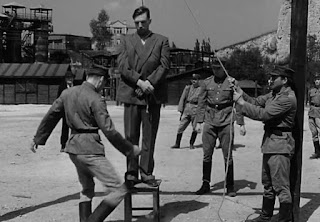The death pit
The death pit
A horrific photograph of an execution in eastern Europe during the second world war can be seen in Holocaust archives and museums around the world. But who are the killers, who are the victims, who took it - and why? Janina Struk felt compelled to investigate
Two naked men stand on the edge of a pit, an older man several feet behind them, while a man and a boy, also naked, walk into the frame. Surrounding them are seven perpetrators, some armed, some in uniform, some not. A uniformed man on the far right-hand side of the picture is standing on a mound of earth, presumably dug from the pit, seemingly directing proceedings. The caption reads: "Sniatyn - tormenting Jews before their execution. 11.V.1943."
I first saw a copy of this image as I was filing through photographs in the Polish Underground Movement (1939-1945) Study Trust in west London. At the time I did not understand what I was looking at. I had never encountered a scene quite like it before. The pitiful sight of the hunched figures thoroughly shocked me. The child is still wearing a hat and the elderly man to his right appears to be wearing a shoe or a sock, as though made to undress in a hurry.
I felt ashamed examining this barbaric scene, because it seemed to make me complicit with the assassins. But I was compelled to look, as if the more I did, the more information I could gain.
It was difficult to find a context for this photograph. It was apparently taken during the second world war, but could it be defined as a war photograph? It was not apparently taken by any accredited news organisation. It did not show the dead strewn on battlefields, nor exactly the devastating consequences of war on civilians. Instead, it appeared to show four men and a boy passively awaiting their execution.
I asked the archivist if she knew who had taken the photograph. She didn't. I understood from her look that she regarded this question as irrelevant and somewhat morbid. Wasn't the existence of the image evidence enough of the barbarism of the Nazis?
But were those in the photograph Nazis? No archivist or historian I have consulted has been able to identify the uniforms or suggest who the perpetrators might have been. I did locate the former Polish town of Sniatyn, now in Ukraine, near its border with Romania. In September 1941, Sniatyn came under German administration, but had previously been briefly under Romanian and then Hungarian control. Between September and December, hundreds of the town's 3,000 Jews were murdered in death pits in the nearby forest. This type of execution - groups of people lined up on the edge of pits, which they had been made to dig themselves - was not unusual dur ing the early years of the war in the east. The victims were often made to undress, partly to humiliate and degrade them, partly so that their belongings could be confiscated or recycled.
In April 1942, deportations began from the ghetto at Sniatyn to the death camp at Belzec, and by September almost the entire Jewish population had been transported there and murdered. So by May 1943, the date of the caption, there were no Jews in Sniatyn.
I wanted to know if those in the photographs were in fact Jews. Or Gypsies, Poles or communists. Were they aware that they were being photographed? Was there a lull in the proceedings so that the photograph could be taken? And why was the picture taken? Was it an official photograph for the files of the Reich or an unof ficial photograph, a memento for the album of a Nazi or sympathiser? I knew that not only Nazis but also ordinary German soldiers obsessively photographed such crimes.
There is evidence to show that the photograph was distributed among the German occupying forces in Poland. At the US Holocaust Memorial Museum (USHMM) archive in Washington DC, I found a photo album donated in 1990. On one page were two photographs. One, part of a series, was taken in Bochnia in south-west Poland in December 1939 when 51 inhabitants were taken to a nearby forest and executed. It shows civilians digging a grave surrounded by German soldiers. The other is the "death pit" photograph. The only information the donor gave was that he had found the album, which had belonged to a German, in an apartment in Sosnowiec in Silesia, after the end of the second world war.
That this image appears in an album is not unusual. Making photo albums was a popular pastime among all ranks of the German forces. Albums before the war, which were made to depict an idealised version of family life, now became a way of celebrating a much greater ideal: the unity and purity of the nation state itself. The original Bochnia series was in another photo album found in the home of a former SS man in Bavaria. It contained a detailed police report of the "course of action" taken in Bochnia, together with the pictures. The death pit image is not among them.
It is not known when the death pit photograph first reached Britain. But the fact that I found it in the Study Trust suggests that it was sent during the war by the Polish underground. The Polish government-in-exile, based in London from June 1940, received thousands of smuggled photographs and documents from occupied Poland which showed the terror unleashed on the population.
To the Poles and the Jews, these images were of paramount importance as evidence of atrocities and war crimes. Who took them, where, when and why, was not important. What mattered was what they showed, or seemed to show. Among Allied governments, however, such information derived from Polish, Jewish or Soviet sources was often dismissed as propaganda.
After the war, these documents and pictures were divided between the Study Trust and the Polish Institute and Sikorski Museum. Both archives have several copies of the death pit image. At the Sikorski Museum, I found copies of the Bochnia series, including the master copy of the grave-digging picture which appeared with the death pit photograph on the page of the album in USHMM.
I travelled to Bochnia and spoke to the curator of the town's history museum. She suggested that the photographs taken in Bochnia could have been distributed during the war by a Pole who worked in a local photo laboratory. This man was known to have made copies of other photographs to smuggle to the underground. Maybe the death pit photograph was one of them? If so, was it he who wrote the caption? At the Study Trust, I found a copy of the death pit picture mounted on this occasion alongside a photograph which shows eight men standing in front of a car. It resembles a snapshot of a group on a day out. Most of the group are looking towards the camera; one is drinking from a bottle. Some of the same perpetrators are in both photographs. Was it taken on the same day, before or after the presumed execution? The caption, in Polish, reads: "Execution in Sniatyn."
I have visited archives in Poland, Israel, Ukraine and the US and the death pit image appears in almost all of them. It has also featured in many exhibitions. In 1995, to commemorate the 50th anniversary of the liberation of the camps, an exhibition entitled the German Army and Genocide opened in Germany. Here, the photograph was located as "presumably in Latvia, summer 1941". The perpetrators were said to be "members of the local auxiliary forces (presumably Latvians)". In other permanent exhibitions, it is not captioned - for example, at Yad Vashem in Jerusalem and at Auschwitz-Birkenau in Poland. The photograph can also be found on a host of websites, one of which locates it in the former Soviet Union.

.jpeg)
.jpeg)









Comments
Post a Comment